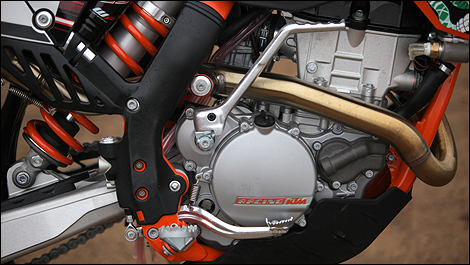Four-stroke engines continue to evolve and grow in popularity. You can find them everywhere, from the road to the track, and from motocross to supermoto races.
As a matter of fact, these engines are all the rage in motorcycle racing. Even a series like MotoGP no longer uses two-stroke powerplants, a decision that pleases manufacturers which have now all adopted four-stroke units for their sporty road-going models. In the top class, 500cc engines were replaced with 800cc variants and then 1,000cc four-strokers, while in Moto2, 250cc engines disappeared, giving way to 600cc units. More recently, in Moto3, 125cc bikes were discarded in favour of 250cc four-stroke, single-cylinders.
 |
| Photo: Philippe Champoux |
Don't count them out yet
Two-stroke engines have also evolved considerably in recent years, mind you. They're lighter and simpler in design, making them cheaper to build and maintain. Just look at Ossa, a Spanish company that is enjoying a renaissance with a new 280cc, two-stroke engine fed by a direct injection system.
Unlike BRP's E-TEC direct injection technology, which requires ultra-powerful and costly injectors, Ossa's (developed in collaboration with Kokusan) uses two traditional injectors per cylinder. The first injector is mounted behind the cylinder and angled to spray fuel in the direction of the spark plug. The second sits under the crankcase and sprays fuel and oil for a more conventional injection and lubrication process.
The result is more efficient combustion with fewer unburnt fuel and oil particles than a standard two-stroke engine. More importantly, fuel economy is higher than a similarly powerful four-stroke engine.
Uncertain future
Realizing that one should never put all their eggs in the same basket, off-road bike companies quickly came up with a plan. In addition to Ossa, Beta is working on a two-stroke lineup, KTM is busy preparing two-stroke models for its Husaberg division, and Gaz Gaz is putting its four-stroke project on hold. Visibly, fears about the four-stroke engine's future are real, and they can be felt almost across the the entire industry.
The only certainty is that Japanese manufacturers will never go back, as the highly lucrative U.S. market dictates the way to go. In case you didn't know already, Americans have grown sick of two-stroke motorcycles and their obnoxious smell. Ironically, though, they're still fond of two-stroke snowmobiles, as evidenced by the number of such models in the 2013 Polaris and Arctic Cat catalogues.
Pros and cons of 4-stroke engines
Some people claim that four-stroke engines are a better fit for enduro bikes: no fuel-oil mixture, increased range, and more flexibility. Others say that they're higher-maintenance, costlier in the long run, and more vulnerable when you stretch out tune-up intervals.
In reality, experts have demonstrated that, no matter which type of combustion is used, elaborately designed, technologically advanced engines with a high performance-to-displacement ratio present the same benefits and drawbacks. Sure, four-stroke units are more expensive to manufacture, but not to develop. Several bike manufacturers that have invested a lot in them so far seemingly don't want to make a different move.
All in all, it looks to be a matter of tastes and needs. The war between two- and four-stroke engines is far from over. Which configuration will come out on top? Hard to say right now. And don't forget about electric motors, which keep making significant strides and could soon alter the battlefield.

